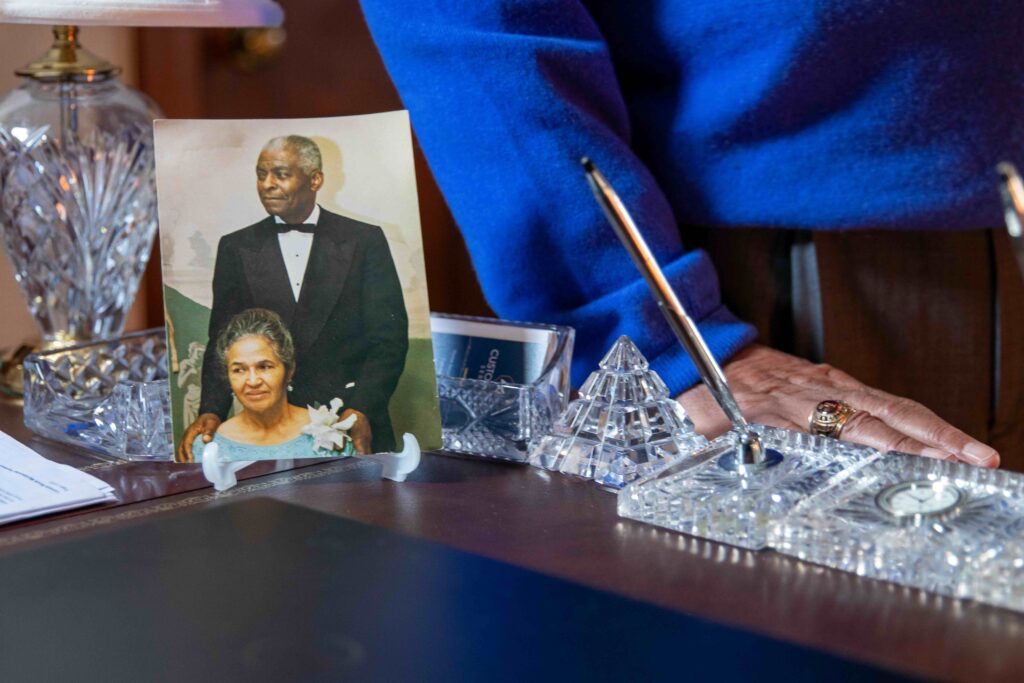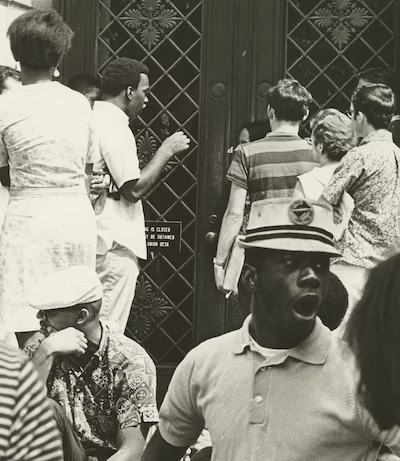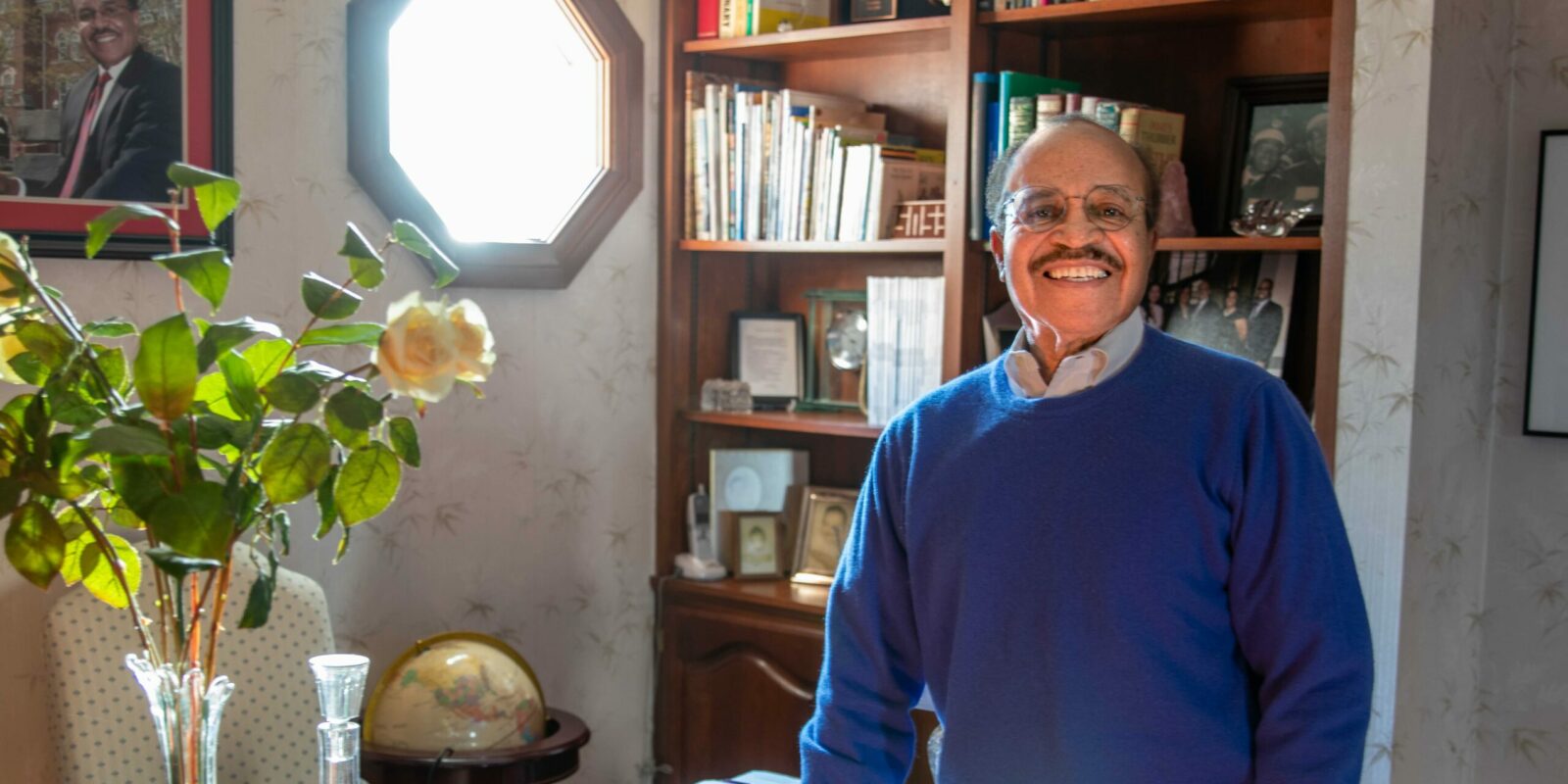The books arrived at Mac Stewart’s rural-Georgia high school in the bed of a pick-up truck. Dog-eared and marked with names of students Stewart would never know, the hardcover texts were unloaded and distributed to his Black classmates.
The white students at the school across town had received brand-new history texts; they no longer needed the old editions. Even then, something didn’t sit right with Stewart. He spoke up in a school meeting.
“And so now we have to get their discarded books,” the young Stewart said.
“Mr. Stewart!” his principal intoned.
“Yes, sir?” the 10th-grader replied.
“Do you know everything in that book?” the principal asked.
“No, sir.”
“I rest my case,” the principal said.
It was 1958 — five years before the Birmingham March. It would be three years before the Freedom Riders tested a Supreme Court ruling allowing people of color to sit anywhere on a bus. A decade would pass before Stewart would be stunned to his core after a famed preacher he personally knew was assassinated while fighting for racial freedom.
Stewart, ’73 PhD, would one day become vice provost for minority affairs at The Ohio State University, pushing for educational equity for any student who needed help. But in 1958, his principal was doing his best to prepare his students for the struggle ahead of them. Stewart read the outdated book, imperfect as it was.
Thriving, not just surviving
Soft-spoken and amiable, Stewart was never one to command the spotlight in his roles as Ohio State’s dean of University College, associate provost for undergraduate studies and vice provost of minority affairs.
“He stays out of the radar. He deflects the shine,” said James L. Moore III, whom Stewart recruited in 2008 to be the inaugural director of the Todd A. Bell Resource Center on the African American Male. Moore still directs the center, and is a distinguished professor of urban education in the college. Under Stewart’s mentorship, Moore later served as chief diversity officer and vice provost in what became the Office of Diversity and Inclusion.
“Some people will jump to take credit when they really had nothing to do with (the success),” said Moore, now on loan for up to four years to the National Science Foundation as its assistant director for the Directorate for STEM Education. “But that’s not Dr. Stewart. He has a collectivistic kind of worldview, not individualistic.”
Throughout his career, Stewart’s primary goal was always to give a boost to students who need it the most — whoever they might be — so they’re “not just surviving, but thriving,” he said.
Stewart himself had been such a kid back in 1958 — economically disadvantaged, from a family of nine, with parents who did not graduate from high school. But one day, his history teacher sought out his father at a Forsyth, Georgia, grocery store, to tell him his son was “Morehouse College material.” His dad, a forklift operator at Robbins Air Force Base, told his son to apply.
“I probably wouldn’t have applied,” Stewart now says, “because I thought I couldn’t cut it at Morehouse,” one of the top historically Black colleges and universities in the country. He applied anyway and got a scholarship through the National Defense Education Act — legislation spurred by a Russian-launched satellite that suddenly made Americans insecure about the country’s lack of education access.
Only one other Stewart sibling also attended college. Tuition was simply beyond his family’s means. His story was one he’d see repeated throughout his career.
Marked by events around him
Stewart speaks with a faint Southern drawl about his path from a two-room, clapboard schoolhouse to a vice provost’s office at one of world’s largest universities.
He was 12 in 1954, when the U.S. Supreme Court ruled in Brown vs. Board of Education that school segregation is unconstitutional. But it would take many years, and many more court cases, before the ruling would be acted upon, although imperfectly.
“When I started going to Forsyth (schools) in the eighth grade, I was bussed about 10 miles,” Stewart said. “That was to achieve segregation. … That would have been between 1955 and 1959.”
In fact, Stewart would attend, teach in or work in segregated education systems until he was 28, when he was admitted to Ohio State’s higher education doctoral program in 1970. But during his undergraduate years at Morehouse, he found a silver lining. Among the majority Black faculty and numerous alumni he found brotherhood and iconic role models.
“We had chapel every day, but that was not a religious service,” he said. “They paraded people before us who would speak of the humble circumstances where they (had come from). … They had PhDs from Chicago. They had excellent jobs, did government and international work.”
“You saw before you someone who made it against the odds. And you would feel, ‘Okay, if that guy did it, I can do it,’” he said.
One such graduate was quickly becoming a leader in the Civil Rights Movement. Stewart often saw Martin Luther King Jr. on campus when the 1948 graduate taught a philosophy course. He heard King preach in Atlanta’s renowned Ebenezer Baptist Church, and he came to know the minister’s parents, sister, brother and wife.
“I knew them in the way that they recognized me, and I recognized them,” he said. “I wouldn’t say I was around their dinner table every Sunday, no. But we were in settings together very often.”
As he pursued his sociology degree, Stewart became more and more grounded in the call to combat poverty by creating equity. The message was true to his experience.
After teaching history for one year at another segregated school and then earning his master’s in psychology from the University of Atlanta, he became director of student financial aid at Morehouse. For four years he worked to help low-income, first-generation students get admitted into college.
“I wanted to see how I could motivate and inspire and give hope to the hopeless — those who felt that there was nothing out there for them, that there was no way they could get through,” he said. “Often, finances happened to have been the reason. They had not had the exposure. … If (there was) some way that I could get to these students to let them know there is hope, there is a way, and I want to help.”

King’s assassination in 1968 shook the world, further challenging American ideals. Morehouse President Benjamin Mays delivered King’s eulogy; Stewart was among the mourners listening. As the country erupted in protests, the implications for higher education were great.
“Universities felt they had to respond to the injustice,” Stewart said. “Many institutions responded to become more diverse, to be more supportive” of Black students.
Realizing that he would need an advanced degree if he wanted to have greater impact, Stewart applied to the college’s Higher Education and Student Affairs program and was accepted. It was the first time he had enrolled at a predominantly white education institution. He was among only a handful of Black doctoral students at the entire university.
Researching disparities, creating solutions

In 1968, protests erupted inside Bricker Hall after four Black students were forced off a campus bus by the driver and allegedly harassed by campus police. Students demanded that leadership address education inequality, racial disparity and police misconduct on campus. The university responded by creating the Office of Minority Affairs in June 1970. It would be renamed the Office of Diversity and Inclusion in 2012. Two months later, Stewart began his doctoral program in the then-College of Education.
Philip Tripp, a force of nature in the study of higher education and described as “a mentor without peer,” was Stewart’s advisor. Roosevelt Johnson, a rare scholar of color studying Black students, and Robert Silverman, then-editor of The Journal of Higher Education, were among his influencers.
Stewart researched student financial aid, “examining how aid is awarded and how equitable it was,” he said.
His findings informed the College Board that Black students had significantly fewer summer earnings, less parental financial support and significantly more education costs than their white counterparts.
As he conducted research, Stewart worked as residence hall director at Stradley Hall — then a men’s dorm that housed 500 students. (Morehouse — his alma mater — had a total student body of 800.) Many Stradley residents were football players.
“At Morehouse College, no emphasis was given to athletics, especially football,” he said. “We had a team … (but) those who played were not worshipped in the way that Ohio State football was.”
Stewart, who is 5’7”, recalls seeing a linebacker collide with a door on Stradley’s seventh floor.
“This person hit that door with his strength and just split the door — boom!” he said. “And I said, “Yes, sir, you have just bought yourself a door.”
“That hall director,” he later overheard a student say, “treats football players just the same as other students.”
Advocating for the voiceless
Stewart put his dissertation studies and Morehouse experience to work in Ohio State’s Office of Student Financial Aid. On leave from Morehouse, he intended to return to continue helping low-income students earn degrees. But before finishing his dissertation, he received job offers from Duke, University of South Carolina and a small Pennsylvania college. Then he got the offer to become assistant dean at Ohio State’s University College, supporting diverse students.
“The position was responding to what was going on in society at that time,” he said.
He accepted the position in 1973, promising his wife they’d return to Atlanta after one year. “She kept the china packed for 13 years,” he said, before eventually emptying the boxes. They still live in Ohio.
Stewart worked with Williams Jimmerson Holloway, the inaugural provost of minority affairs, to recruit and retain students of color. Just how many Black students were enrolled at Ohio State is up for debate, because Ohio State and other universities didn’t consistently maintain data about student race until 1985. But one study estimates that Black students in the late 1960s accounted for no more than 1-2% of Ohio State’s student body. Nine percent of Ohioans were Black at that time. Stewart and others across campus were determined to level the playing field.
“University College worked with students to complete prerequisites,” he said. “This was an ideal place to put programs in place to help students thrive — tutoring, counseling, advisors. It was a new area. A key part of that was money” — to fund programs and scholarships.
Stewart advocated before the Ohio General Assembly on behalf of all state higher education institutions, seeking funds that allowed more diverse Ohio students to enroll in higher ed. When he became dean of the University College in 1990, 5.2% of Ohio State’s Columbus campus students were Black. But in 2000, when he was tapped as vice provost of minority affairs, Black students comprised 7.7% of the student population.
Moving forward while losing ground
The year Stewart became chief diversity officer of the university, President William “Brit” Kirwan launched a comprehensive plan.
“’What do I believe in? Diversity,’” Stewart recalls Kirwan telling the Council of Deans. “He said, ‘We’re going to develop a diversity plan. And you…’ he looked at each one around the table, ‘are not going to let me down.’”
Kirwan recognized something Stewart came to understand at Morehouse — diverse students need some diverse faculty to believe they also can succeed. Kirwan challenged deans to hire them, and Stewart’s office helped recruit.
Their scope also was expanding.
“Because the meaning (of diversity) is broad, it has come to mean many things to different people,” the action plan said. “The term is used to refer to different religions, different social class or political philosophies, different capabilities or accomplishments, different sexual orientations, or different races, ethnic groups, and gender.”
Stewart’s team drilled down to recruit and support white students from high-poverty, rural areas, especially in southeastern Ohio. The office supported Latine and indigenous students and those of varying faiths and beliefs.
But as they studied who was most at risk for dropping out, the data was clear. In 2005 Stewart founded the Bell National Resource Center on the African American Male, named after football-great and alumnus Todd Anthony Bell, who worked to improve Columbus neighborhoods and create inroads to higher education after retiring from the NFL. The center supported young Black men and provided role models for their success.
“That was my brainchild, because when we looked in America to the greatest challenge in education, African American males needed the most support,” he said. “I chose the right person to run it.”
Stewart named Moore the center’s first director in 2008. Moore expanded mentoring and tutoring programs and later helped secure scholarships from influential partners who shared his vision: real estate developer Bob Weiler and Chase CEO Jamie Dimon. Adding resources helped students soar.
“At some points, we would have 500 and upwards African American males walking around campus with GPAs of 3.0 and higher,” Stewart said. The university became known for developing Black male student success. Dozens of universities and colleges contacted the center to learn from its success.
But Stewart’s office had no control over one critical aspect of enrollment. Through the early 2000s, the university greatly raised standards for admission. Black students were being better supported, but fewer were being admitted.
“We were trying to amplify or ratchet up our prestige academically,” Moore said. “And in turn, the most vulnerable are typically the most impacted. It’s more visible with African Americans, but it’s also true for some of the white students who grew up in rural areas.”
In 2010 — the year Stewart retired from Ohio State — the country saw the highest overall college enrollment of Black students in 30 years, 15%. But Ohio State’s Black enrollment had slipped to 6.2%.
Inclusion services became more critical than ever. That hasn’t changed, Stewart said.
“We need to protect the rich social diversity of our species,” Stewart wrote in the 2000 action plan, “and act on the assumption that every culture and every individual has … important gifts that can benefit us all. We as educators have the professional duty to seek out their gifts and talents wherever they can be found and to nurture them.”
Last year, the U.S. Supreme Court struck down race-conscious college admissions. More than 20 states considered or passed new laws targeting diversity and inclusion efforts. A few politicians — including Ohio State graduates — have advocated for ending supports that Stewart and others put in place.
“It’s like building a house to get to where you are,” he said. “We helped to make the campus more diverse in many ways. I don’t know how you go back to where we came from.”
Stewart is mindful that the world hasn’t progressed enough since he wrote his dissertation. Black college students still are more economically unstable. Economically disadvantaged students still struggle to enjoy what they eat in dining halls knowing that, at the same time, their families are hungry, he said.
Inner city and rural students still read outdated books and use inferior technology. They enter college — if they are so lucky — lagging behind their privileged peers. But given adequate support, one generation can build upon another. Through education, one by one, people can reach beyond their circumstances. That’s the most Mac Stewart ever hoped for.
“What I appreciate about him…” Moore said, “is there’s no bitterness. The healing is in the pain. There’s a proliferation of excellence that exudes from him, and that’s what he brought to bear to Ohio State and beyond.”

